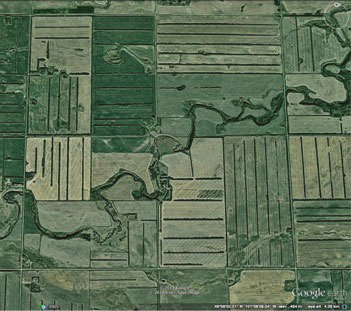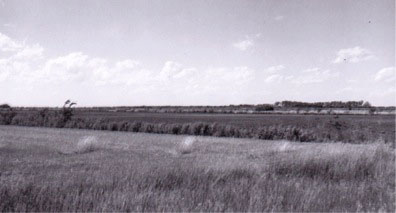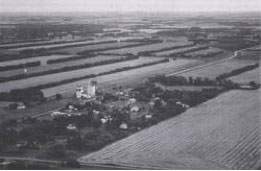HOME
1. Introduction
2. Historical Overview
3. A Scientific Approach: Experimental
and
Demonstration Farms
4. The Greening of the West
by Lyle Dick,
Parks Canada
5.
The Lyleton Area
Shelterbelts
6. The Indian Head
Shelterbelt Centre
7. The P.F.R.A
8. The Gerald Malaher
Wildlife
Management Area
9. Arbor Day & Tree Stories
10. Shelterbelts and Modern Agriculture
11. Links & Resources
|
5. Lyleton Field Shelterbelts by
Jim Murray
Originally
published in the R.M. of Edward History
The
early homesteaders found a sea of waving grasses, bluejoint, and
other native hays. They plowed them under. The result: hot, dry,
prairie winds often blew their freeholds into the next township.

Near
Lyleton Mb.
The
early farmers soon realized what had to be done. They knew that at
home in Ontario, the British Isles or the Ukraine, native stands of
trees and shrubs protected cultivated cropland from erosion. Not only
would trees catch and hold the moisture in the soil, they would provide
windbreaks for home and herd. But natural tree growth on the prairies
was restricted to spring fed coulees and lowland river valleys. The
only answer was to grow seedlings in nursery plots and transplant them
on the prairies.
In 1935
Parliament passed the "Prairie Farm Re- habilitation Act",
(P.F.R.A.). Subsequently, thousands of dugouts were to catch and hold
spring runoff water and new tree planting projects flourished.
In 1936
Baird and Will Murray of Lyleton petitioned P.F.R.A. to
establish, the Lyleton Shelterbelt Association. With Baird as president
and Will as secretary, the P.F.R.A. backed them to the extent of $5 per
mile for planting, plus $20 per mile per year for three years for
maintenance.
The
department sent in Des Crossley as supervisor and under his
direction the first plantings were completed in 1936. They consisted of
one-half mile planting of 2300 trees on the farm of C. E. Fennell. In
1937, 27 farmers planted 35 miles of shelterbelts, which meant planting
375,000 trees. In 1938, 39 miles of trees were established. The
varieties planted were caragana, ash, elm, maple and willow.
Originally
the project was set up to run for five years, but the
success of the program and the interest shown by the farmers caused it
to be extended several times. It was finally terminated in 1959.

Near
Lyleton, 1960. Photo by J. Warkentin courtesy the Manitoba Archives
During
the periods 1936-1959 some 97 farmers planted 364 miles of field
shelterbelts over a 60 square mile area, involving 2,386,000 trees. The
total cost of the assistance supplied by the Federal Government
approached $28,000. All the tree material was supplied free of charge
from the Forest Nursery Station at Indian Head. The farmers planted
most of the trees by hand, hoed them by hand for three years, as well
as cultivating on both sides.
Additional
Information: From Local Histories
It would
be folly to try and name all those who gave their enthusiastic
support to this project. It is sufficient to say that the majority of
the residents in Township 1-28, and also the townspeople, believed that
this enterprise would be the salvation of this area. As a result the
Lyleton district would once again be a viable and prosperous farming
community.
The New
Era reports that in October 1937 Shelterbelt Association
executive consisted of: President, Cecil Murray; Vice-President, Cliff
Fennell and Secretary, Fred Hill.
Today
these rows of trees are stately and arrow straight, attracting
scores of visitors to Lyleton, just a few minutes' drive from the point
where the boundary of Manitoba, Saskatchewan and North Dakota meet.
Over the
years the field shelterbelts have proven beneficial in keeping
the snow in the fields, conserving the precious moisture and slowing
down the prairie winds. Some of those early plantings now tower 60 feet
in the air. They are a living tribute to the far sightedness of the
farmers of that era.
The
following letter was received, following inquiries by the History
Book Committee, from D. 1. Crossley, who was involved in the planning
of the Lyleton Shelterbelts.
Dear
Jim:
I note
the history writing project in which the community is involving
itself. This is a worthwhile endeavor and I will try to satisfy your
request. It is hard to realize that forty-seven years have gone by
since we started the Lyleton Field Shelterbelt project. You have
provided the pertinent information on the "raison d'etre" for the
establishment of this study. Four projects were initiated across the
prairie provinces and your community had the initiative and drive to
attract one of them
A
prairie boy myself (Lloydminster, Alberta) I graduated in Forestry
from the University of Toronto in the spring of 1935. At this time jobs
were very difficult to obtain but I was fortunate to be offered a
position under the P.F.R.A. in the completely new field of prairie
silviculture, with headquarters at the Dominion Forestry Nursery
Station at Indian Head, Saskatchewan, and was immediately assigned to
the Lyleton project.
Southwestern
Manitoba was completely new country to me. The light soils
and the scarcity of precipitation over the preceding years made it a
likely and challenging area for the establishment and subsequent study
of shelterbelts to retain the drifting winter snows and to minimize
soil movement and moisture evaporation.
Baird
and Will Murray were my initial contacts with the newly formed
Shelterbelt
Association
and I was soon made to feel at home in the community, fully
sympathetic with the problem it faced of retaining the viability of a
farming community over the adversities it was experiencing. In an
honest effort to record my perception of the task to which I had been
assigned, it soon became evident that the initial membership was
dedicated to the goals of the study project and that the farm lands to
be removed from the agricultural land pool in order to support the
shelterbelts to be established would be justified. On the other side of
the fence were farmers who were not so convinced and held back. This
was unfortunate because the success of the project might depend on the
mass effect of a compact series of shelterbelts on adjoining farms.
However, farm incomes during the 30's were at a minimum, and many of
these unconvinced farmers were subsequently attracted to sign up,
simply because of the federal financial assistance.
It
cannot be recorded that the initial results were encouraging.
Caragana was the initial tree species that was considered to have the
best possibility of establishing under drought conditions. Spring
survival following planting was comforting, but an un- expected danger
awaited the advance of the season from blister beetle that were
attracted to this new source of food with rapid defoliation the result.
Emergency control measures were initiated by dusting with an
appropriate insecticide, with moderate success. Those trees that
succumbed had to be re- placed the following spring, only to require
further dusting. These unexpected expenses were born fully by the
Department. At this time more thought was given to the incorporation of
other species that were immune to this insect's attacks. As a result,
and because of the improving climate, the belts became established and
form the stately avenues that dominate the rural scene today.
At this
point I would like to record my own memories of my involvement
with the Lyleton community during the initial five years. I was 24
years of age in 1935, single, just out of University and anxious to
become a part of the type of community in which I was nurtured. I found
it in Lyleton, when I became part of the Ma White household which
included Joe Mustard, local entrepreneur, Willard (Stoop) Allan, Seward
Smith, both of whom were federal entomologists battling with the
study of grasshoppers, and other civil servants passing through from
time to time. Ma White was not at all hesitant in showing disapproval
of our exuberance and lack of piety, but I do think she regarded us as
her family and I will be forever grateful that I had the opportunity to
be part of it. She was an excellent cook, forever pressing further
consumption upon us. In 1937 I took my bride with me and she was taken
into the community as readily as I had been.
In the
light of present day sophistication I am nostalgic over the
simpler forms of entertainment that characterized the community at that
time: the corn roasts we enjoyed at the old swimming hole, the Saturday
night trips to Antler to enjoy a bottle of beer to the strains of Clyde
McCoy and his" Sugar Blues" played over and over again on the Juke box,
and the baseball games in which I was invited to participate whenever I
happened to be in the community at the right time.
I could
go on and on. 1940 was the last year of my participation in
this project. Wartime obligation had to be satisfied, and upon
discharge in 1945 I severed my employment with the Federal Dept. of
Agriculture and took up employment elsewhere, but we will always
remember the good years my wife and I spent among you.
Sincerely,
D. Crossley.
Lyleton
Shelterbelts
Originally
Published in Vantage Points
http://vantagepoints.ca/pages/publications
Shelterbelts
in the area around Lyleton ensured the viability of
agriculture during years of drought 1936-1959.
The
Need for a Wind Break
Stately
rows of trees line the gravel roads near Lyleton, Manitoba.
From the sky one could imagine the fields of the region resembling a
striped tablecloth that has been draped over the landscape, changing
colours with the seasons. Regardless of the poetry one could write
while considering such a metaphor, the planting of the shelterbelts in
and around Lyleton served a much more practical purpose.
 The
shelterbelts near the town of Lyleton are captured in this picture:
looking northeast in August, 1979.
The
shelterbelts near the town of Lyleton are captured in this picture:
looking northeast in August, 1979.
Settlers
first arrived in the area of Lyleton in the 1880s. They found
in front of them an almost endless expanse of native prairie grasses,
bending to the will of the wind. The intended purpose of the settlers
who populated the region was to farm. Therefore, these native grasses
were tilled under without a thought to what their absence would mean:
prairie winds gusting unhindered across the landscape.
The
PFRA
In 1935
the Government of Canada launched the Prairie Farm
Rehabilitation Act (PFRA). The following year two Lyleton locals, Baird
and Will Murray, petitioned the PFRA to establish the Lyleton
Shelterbelt Association. The PFRA provided $5 per mile of planted
trees, with an additional $20 per mile, per year for the following
three years of maintenance.
Stately
Rows of Trees
The
first of many shelterbelts to be planted in the region was
completed in 1936. It consisted of 2,300 trees which were planted in a
row measuring half a mile on C. E. Fennell’s farm.
At
first, caragana trees were thought to be the most appropriate tree
to combat soil drifting due to severe drought. However, the caraganas
ended up suffering from local blister beetles, which regarded the trees
as an exciting new source of food. Additional varieties of trees
planted afterwards were ash, elm, maple and willow.
In line
with the hopes of local residents, the trees were found to be
very effective at keeping soil erosion to a minimum. They also kept
winter snows from blowing away, conserving more moisture on the fields.
The shelterbelts were instrumental in retaining the viability of
agriculture in the region during the Dirty Thirties and afterwards.
The
trees also changed the aesthetics of the region. Where previously a
vast area of open cropland had existed, there appeared 30- or 40-acre
strips of land, bordered on each side by arrow-straight rows of trees.
Wildlife, too, found the trees to be an attractive addition to the
region. Moose, elk, deer and sometimes cougars have found accommodating
habitats within the shelterbelts. New species of birds have found homes
in the tree branches, adding their song to the a ea. The region
continues to be a popular birding destination today.
The
Project is Extended
The
project was set up to run for only five years, but due to its
success it was extended several times, and ran for a total of 23 years.
By the project’s end in 1959, 97 farmers had been involved with the
planting of 364 miles of shelterbelt, made up of 2,386,000 trees, over
an area of 60 square miles. The expense of the project to the federal
government was $28,000. Most of the trees were planted by hand and
maintained using hand-held hoes. Many of the shelterbelts planted in
the 30s and 40s remain today, though the need for them is not as
critical as it was in the years of dire drought. Recently farmers have
begun tearing down the trees in order to increase the amount of land
available for crops.
Author:
Teyana Neufeld
Sources:
Neale
Daniels. Personal Interview. 21 June 2010.
RM of
Edward History Book Committee. Harvests of Time. Altona: Friesen
Printers, 1983. pp 83-85.
Photo:
RM of Edward History Book Committee. pp 84.
|



